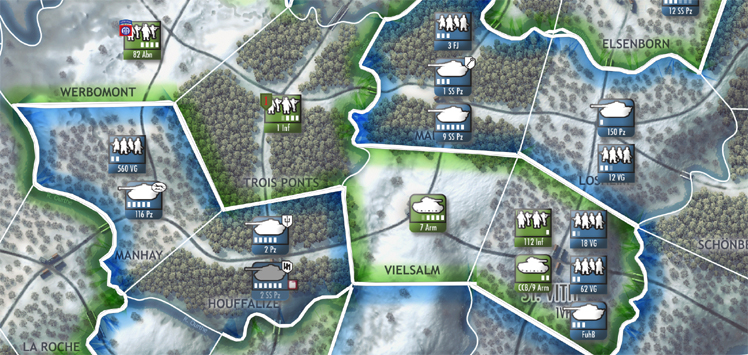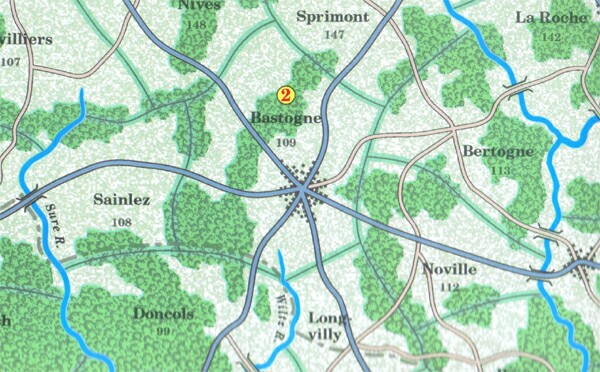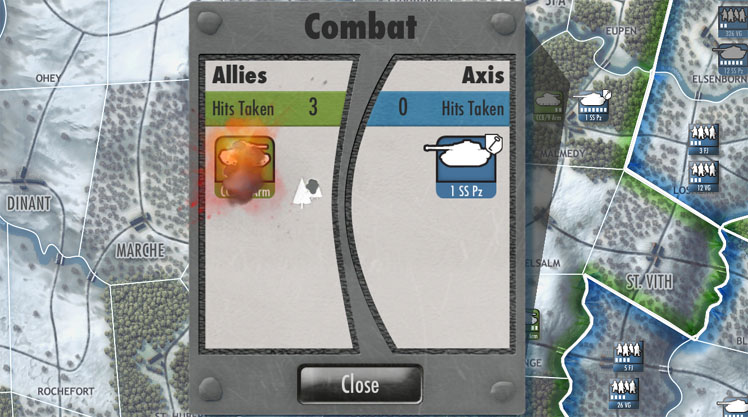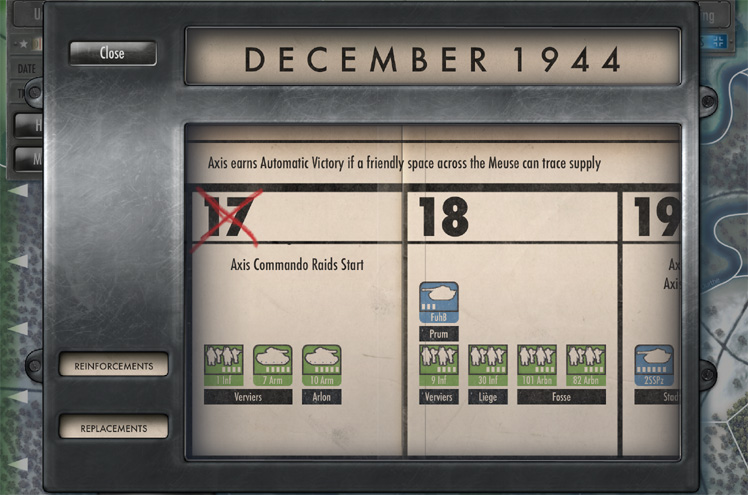 A very accomplished game designer once told me his best ideas were mostly borrowed, but that he made them his own in the way he arranged and adapted them to a setting. Part of good design, he said, is knowing what works in a particular situation, and why. Good ideas keep coming around in new forms for a reason. They are borrowed, adapted and thus evolve, while the bad ones are discarded.
A very accomplished game designer once told me his best ideas were mostly borrowed, but that he made them his own in the way he arranged and adapted them to a setting. Part of good design, he said, is knowing what works in a particular situation, and why. Good ideas keep coming around in new forms for a reason. They are borrowed, adapted and thus evolve, while the bad ones are discarded.
So it always puzzled me that computer wargames didn’t seem to have this evolving pool of good ideas. Instead, too often they were races to the bottom of some massive simulation pit, at the nadir of which was presumably an infinitely complex reality modeling engine. In retrospect, it was logical: when your platform is a supremely powerful computation device, it makes sense to make it compute as much as possible.
But nothing shakes up the status quo like a new platform that behaves like a new habitat, forcing its inhabitants to adapt or die. John Butterfield’s Battle of the Bulge feels like a game designed from the ground up for the tablet and its touchscreen*, where simple rules and clean design are ambitions instead of compromises. It’s also a fascinating example of how a hobby that once strove for superlative accuracy is willing to compromise in the name of superlative gameplay.
 Shenandoah Studio is “a development studio focused on turn-based strategy games for the iPad”. That sounds unremarkable, until you find out that it consists of some truly remarkable people. Founder and CFO Nick Karp designed Vietnam 1965-1975, one of the most brilliant strategy designs I have ever seen. Co-founder and CEO Eric Lee Smith is an accomplished graphics artist and a veteran of SPI and Victory Games. David Dunham was producer, designer, and programmer for King of Dragon Pass. John Butterfield has to his credit an amazing list of boardgames, including R.A.F., possibly the best solitaire wargame ever published. And others, whose individual mentions would push this word count to critical levels. In short, a game from Shenandoah Studio is the product of as much game design and production expertise as will likely ever be deployed in the cause of tablet wargaming.
Shenandoah Studio is “a development studio focused on turn-based strategy games for the iPad”. That sounds unremarkable, until you find out that it consists of some truly remarkable people. Founder and CFO Nick Karp designed Vietnam 1965-1975, one of the most brilliant strategy designs I have ever seen. Co-founder and CEO Eric Lee Smith is an accomplished graphics artist and a veteran of SPI and Victory Games. David Dunham was producer, designer, and programmer for King of Dragon Pass. John Butterfield has to his credit an amazing list of boardgames, including R.A.F., possibly the best solitaire wargame ever published. And others, whose individual mentions would push this word count to critical levels. In short, a game from Shenandoah Studio is the product of as much game design and production expertise as will likely ever be deployed in the cause of tablet wargaming.
But with prodigious talent come prodigious expectations, especially those born of a successful Kickstarter that raised over $30,000 in May 2012 from more than a thousand backers. The team had all the right goals for an iOS wargame: attractive graphics, clean rules, and an interface to match. No true tablet wargame had ever succeeded in all three things. No better example exists than Dan Verssen’s fabulous Phantom Leader, an amazing design saddled with a pedestrian iPad interface. For Battle of the Bulge, with this much design talent, the real question was presentation. Would a wargame developer finally assemble the technical and graphical expertise for a game as polished as Bejeweled Blitz?
What sounds like a straightforward project in reality is anything but. Most hardcore computer wargames feel clunky not because of the interface, but because of the system. SSG’s highly regarded The Ardennes Offensive actually has an excellent interface. But unit stacking, divisional integrity bonuses, engineers, bridge repair, and a laundry list of genre-specific trumpery does nothing to smooth the underlying gameplay, forcing players to dig through screens full of detail to play optimally. Changing that requires changing the whole shooting match.
Battle of the Bulge solves all of these problems by playing directly to the strengths of a tablet. The map fits perfectly on the iPad screen. Area movement means that the spaces are bigger than the counters that can fit in them. Instead of combat factors, you treat all armor the same, and all infantry the same, and you can distinguish those by the unit symbols. All strength is in pips, which are easily visible. By alternating play one unit at a time, each turn is incredibly tense, even more so because each time you move, the clock ticks variably, and you never know when the turn will end. All of which is wrapped up in a polished interface worthy of the most poppy Popcap game.
 None of these tricks is new. In fact, when I started playing Butterfield’s Battle of the Bulge, I immediately thought of Ray Freeman’s forgotten classic Tigers in the Mist (map partially pictured above), published in 1999 by GMT Games (and self-published five years earlier by Mr. Freeman in a ziploc bag). It had area movement, and standardized armor and infantry values, and impulses, as well as the “I shoot, you shoot” combat system which gives Bulge so much of its drama. Freeman has a great summary of his thought process in his designer’s notes that I’m going to reprint here because it seems to apply so well to Butterfield’s game.
None of these tricks is new. In fact, when I started playing Butterfield’s Battle of the Bulge, I immediately thought of Ray Freeman’s forgotten classic Tigers in the Mist (map partially pictured above), published in 1999 by GMT Games (and self-published five years earlier by Mr. Freeman in a ziploc bag). It had area movement, and standardized armor and infantry values, and impulses, as well as the “I shoot, you shoot” combat system which gives Bulge so much of its drama. Freeman has a great summary of his thought process in his designer’s notes that I’m going to reprint here because it seems to apply so well to Butterfield’s game.
My intent was to create a Bulge game that would be easy to learn and fun to play. I also wanted it to be enough of a challenge that serious players could enjoy it as well. The kind of games I enjoy must have clean, straightforward rules systems and are low in complexity, but rich in play possibilities. I want to spend my precious time strategizing, not looking up some obscure rule. The counter quantity had to be manageable, and I wanted the game to be decided at the Meuse River. The Germans are definitely more capable than they were in reality, but otherwise the game would not be as interesting, at least to me.
I hope that Mr. Freeman has ten bucks and an iPad so he can buy John Butterfield’s game, because his objectives sound like action items in a hypothetical Shenandoah Studio Bulge design document. There aren’t a lot of counters, meaning that each move really matters. Choices are clear and require no obscure rules lookup. I didn’t read the manual until after my fourth game, and didn’t learn much, not because the manual is bad (quite the opposite) but because the game had already done such a good job explaining itself through gameplay.
Each move involves activating a single area and moving all of its units. This requires careful planning to consolidate units for activation while still guarding all your objectives. Combat has units shooting at each other rather than abstracting an odds table. Varying strength points reflect unit quality. It’s like someone read Ray Freeman’s explanation of unit strengths in Tigers in the Mist:
Morale and training have been taken into consideration, but not to the extent that it probably affected the situation in real life. It is up to the German player to provide better leadership than did his real life counterparts. For example, the 2nd Infantry Division comprises 4 counters totaling 12 strength points. The 99th Infantry is only 2 counters totaling 6 SPs. This is because the 2nd Division troops were hardened veterans who had picked up a lot of extra weaponry from past battlefields and had considerable AFV forces attached. The 99th was green and didn’t possess weapons in excess of its official TO&E, nor did it have attached AFVs, its TD units [tank destroyers -bg] being all towed guns.
Butterfield’s Bulge works exactly like this, with 99th Infantry having three pips, while 2nd Infantry has four.
The unpredictable end to each day is a variation on the Turning Point: Stalingrad system, where you never knew if you were going to have another impulse. Bulge doesn’t quite have the same feeling as the classic Allen/Greenwood mechanic, but the effect in both is to force you to prioritize your moves, because you’re never sure if that one down the line is going to get done.
As I’ve been told, though, the best designers make established mechanics their own, and whether or not John Butterfield has ever played Tigers in the Mist, his game feels like a unique creation. He achieves much of this by scaling scope to size, and the game feels ruthlessly tuned to the point that each area and unit feels essential. Remove one regiment, alter one area, and you might tilt the game irrevocably in a given direction. The game’s balance is more a teetering edifice, swaying back and forth to the rhythm of the random numbers.

Those random numbers add up to a staggering variety of gameplay eddies and drifts, all incrementally nudged by a result here, a retreat there. While the board starts with the same pieces in the same places every time, each playthrough seems to yield a slightly different focus, a different turning point or dramatic peak. Certain spaces will figure prominently in any game, but even now, after several dozen games and counting, I still seem to remember the time I attacked Werbomont with three nearly full-strength panzer divisions and failed to score a single hit, or when my opponent snuck his tanks off the board through Wanze (huh?) when he destroyed two full-strength American infantry divisions with eight shots. But never did I feel either side was inherently overmatched.
The cost — if you can even call it that — of this elegant equipoise is a serious compromise of historical accuracy. All Bulge games either favor the Allies or pump the Germans full of steroids to make a game out of it. John Butterfield’s design takes even the latter position to an extreme, and I can only assume he wholeheartedly agrees with Ray Freeman’s assertion that otherwise it wouldn’t be as interesting a game.
But lack of historicity does not mean lack of verisimilitude. Battle of the Bulge has just enough “chrome” to make it feel like a Bulge game, without overloading it with minutiae (no Peiper, no von der Heydte airdrops), and it feels perfectly tuned. German artillery has organic range limits, there are random German fuel shortages, and one commando raid can freeze a crucial Allied unit. All of this is in service of the game’s inexorable presentation of choice and counterchoice, and when the fuel shortage rule strands your leading panzer unit just before it crosses the Meuse, it feels like a strategic dilemma rather than an arbitrary obstacle.
The biggest obstacle in all Bulge games, though, is the River Meuse. Like many Bulge games, this one comes with two scenarios. The Race to the Meuse scenario is like every other Bulge race to the Meuse scenario, and the campaign game is like every other campaign game which includes the Allied counterattack. With an important difference. In Tigers in the Mist, I noticed this explanation by Ray Freeman in the designer’s notes for the absence of a scenario covering the whole battle.
I decided early on that I couldn’t deal with the entire campaign. It was just too big, and I think that it is really difficult to design a balanced game where the tide turns completely.
Of all the problems Butterfield’s Bulge solves, this may be the most subtle, but it is in no way the least impressive. Each day is boxed in by a pre-determined victory point floor and ceiling. If the Germans victory point level is through the ceiling, they win automatically. If it’s under the floor, they lose. Anything in between means you keep playing into the next day. But unlike actual floors or ceilings, these things move.
To turn the tide, Butterfield’s Bulge deftly adjusts these victory levels, so that if they Allies stave off a German rush across the Meuse, they can still lose later on when the victory point ceiling for the Germans starts dropping. Because the Germans gain points for holding objectives, they can win by consolidating territory and letting the victory point level come to them. It’s up to the Allies to use their generous reinforcements to divest the Germans of their gains, and it makes the Allied side a challenge to play in both offensive and defensive dimensions. Which is probably where the main difficulty lies.
Ramping up the Germans is a reasonable decision if you’re looking at this as a multiplayer game. And if the game ultimately breaks down, it’s due to the fact that these high-powered Germans are more than the Allied AI can handle. Specifically, even if it survives the initial onslaught, it almost invariably botches the required counterattack, and a decent player can usually consolidate his gains and meet the later victory point threshold. It’s a significant challenge even for a human player, regardless of play style.
Speaking of play style, the AI comes in four varieties, two German and two Allied. There seems to be a “conservative” and a “daring” option for each one, but the distinction is better described as flatfooted versus foolhardy. Although I’ve seen the daring one be the opposite, as well. It has some specific idiosyncrasies to exploit, which you’ll learn after a few playings. One is its ability to be suckered into and then trapped in isolation. Another it its weird predilection for abandoning victory point cities with enemy units adjacent. All in all, it’s clearly at best work in progress, and at worst weak as the Germans and hopeless as the Allies.
But I think Shenandoah Studio has a higher ambition: to present gamers with a focused situation with limited but very meaningful choices. That’s a design which works best between two thinking humans. And it’s telling that the first product from a company staffed by all-stars in boardgame design and art production may come to grief thanks to the one thing that boardgames never had to deal with: artificial intelligence**.
Long ago, almost every gamer was a solitaire gamer to some extent because there were so few opponents around. Now you can email turns back and forth on an exact replica of the gameboard and talk on the computer for free. Or just play against the computer itself.
This fundamentally changes the way we consume our games. The old Avalon Hill classics got a ton of attention over a long period of time because there really wasn’t much else. People argued ad nauseamabout opening setups, strategy, and variants. Modern computer games don’t lend themselves so much to this because most are too dynamic (or just complicated) for this kind of analysis, and we consume game media differently than when it showed up in our mailbox every couple of months.
Are we better or worse off now for it? Who do I look like, Jim Dunnigan? How should I know? But I’d arguethat all the ink spilled on the pages of The General about things like the optimal Western Military District setup in The Russian Campaign suggests part of this hobby is about exploring our interest in history, and we explore it like archaeologists dissecting our games down to their skeletons. But once we’ve dissected them, do we throw them away? Or is that mutual experience the whole point?
That mutual experience has moved to online forums from the pages of The General and Fire & Movement, and long, eloquent articles have been replaced by short, pithy forum exchanges. Is a game a solitary walnut to be cracked in isolated study, or a slow-roasting problem for socially interactive investigation? Is this a mutually exclusive branch point for modern gaming? Make a game too balanced and it’s easy to figure out the AI. Make it unbalanced in the AI’s favor and the multiplayer experience suffers. Make it too small and all the moves get figured out, period. As I pointed out in the War in the East game diary linked above, the time between the publication of “The Viipuri Defense” by J. Richard Jarvinen, and the “Back to the Viipuri” article in which Jarvinen acknowledged Rob Beyma’s deconstruction of his algorithm was four years. A modern-day “perfect plan” for a game as simple as The Russian Campaign wouldn’t last four days.

Computer wargame designers tackled this problem by making games larger and larger, so by the time you solved a game, you had put a few dozen hours into it and probably felt your money was well spent. The systems might still be completely broken, but it gave you the imaginative room to get lost in the subject. The cost was multiplayer balance. Plus, how many times can you playtest a multiplayer game that takes a year to play? I’ve mentioned this before, but the designer’s notes for SPI’s The Next War specifically asked for input from people who managed to play the game further in than the designers did. That was possible for a game with three mapsheets and a thousand counters. A game as small as Bulge could get taken apart in weeks, whereas thirty years ago an impression of a game this size might have taken years to form, while people sat down and played it. In person.
Which is how Bulge should ultimately be played. The alternating impulses, set against the variable number of impulses in a day, played on a board where a fixed setup leads to so many possibilities, add up to a strategy gaming experience that’s both reverentially nostalgic and relentlessly modern. Few games will make you hang on each virtual throw of the dice like Butterfield’s creation, expertly masked by slick animations and sound effects to match. The jump to the iPad puts this kind of game firmly within reach of people everywhere, not just those with dusty ping-pong tables in unused basements.
That’s the best reason to play Butterfield’s Bulge: because it’s simply a great game. You don’t have to know anything special about tanks, or river crossings, or the Luftwaffe. Everything in the game is easily explained: these units move fast, these roads speed movement, these woods impede attackers. Bastogne is still Bastogne, but unlike some more Byzantine recreations of this particular historical moment, that’s just icing for the people who need to break into a German accent when pronouncing “Panzer Lehr”. They could just as easily be elves, or Achaeans, or post-apocalyptic pirates. I guess they could even be zombies. You know, if you like that kind of stuff.
Discussion
No comments yet.